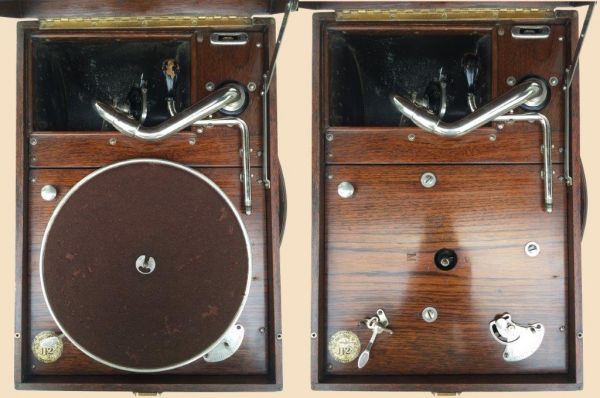HMV Portable Model 112
MANUFACTURER: Gramophone Company of India Ltd., Calcutta
MODEL: Portable model 112
SERIAL NO.:
YEAR: ca. 1928-1933
PRICE: 155 Rupees.
CASE: Highly polished Teak oak finish
TURNTABLE: 10 in./ 25 cm
HORN: internal, zinc-folded
MOTOR: HMV No. 32 double-spring with quadrant speed control
SOUNDOX: HMV No. 4

The Gramophone Company of India Ltd. (a branch of the British Gramophone Company Ltd.), headquartered in Dum Dum, Calcutta, was founded about 1908 and produced phonographs and records for the Indian market. Buyers were primarily the British colonial rulers and wealthy Indians.
Characteristic for models of the indian market or production is the case that was usually made of teak and mahogany sporadically. Teak because it is very durable and weather-resistant and sensitive to environmental influences. It convinces with high strength and hardness.
The surface is a "high polished", which actually corresponds contrary to the usual "satin finish" on mahogany-machines with a pore-filled and high-glossy surface.
Most machines that turns up had a variable history. Many machines reached England with the former owners (British colonialists, the so-called Raj) during their return from India. That´s the reason why one finds these relatively rare models in England and occasionally in Holland.
Whether horn-, tablemodels, cabinet grands or portable gramophones - many models that belong to the standard range of the Gramophone Company in England or were produced in factories in Hayes, were also available in India. In addition, there are a few models that existed only in India or were there produced and sold by the Gramophone Company of India.
This includes the model 112 of the Gramophone Company of India shown below.
It is based on parts of the famous portable model 101 and was available from about 1928-1933. Due to the HMV No. 32 double-spring motor, it had a much deeper case. Because of the weight and the size it was certainly not an ideal portable machine. The Gramophone Company realized that such a heavy and bulky machine would be unsuitable to european conditions. So this model was not adapted to the home-market.
Nevertheless, the Gramophone Company of India produced a successor to the 112 model - an equally heavy and bulky machine, based on the successful portable model 102 - the portable model 114.

Die Gramophone Company of India Ltd. (eine Tochter der britischen Gramophone company Ltd.) mit Sitz in Dum Dum, Calcutta, wurde ca. 1908 gegründet und produzierte Grammophone und Platten für den indischen Markt. Als Käufer kamen primär die britsichen Kolonialherren sowie wohlhabende Inder in Frage.
Charakteristisch für Geräte für den indischen Markt bzw. aus indischer Produktion ist, dass die Gehäuse in der Regel aus Teakholz und vereinzelt auch aus Mahagoni gefertigt wurden. Teak erklärt sich darin, dass Teakholz sehr robust und witterungsbeständig sowie unempfindlich gegen Umwelteinflüsse ist. Es verzieht sich auch bei wechselndem Klima kaum und überzeugt durch eine hohe Festigkeit und Härte. Die Oberfläche ist ein "high polished", was entgegen dem üblichen "Satin finish" tatsächlich einer porengefüllten und hochglänzenden Oberfläche entspricht.
Zumeist haben die Geräte eine wechselhafte Geschichte hinter sich. Viele Geräte sind mit den damaligen Besitzern (britischen Kolonialherren, die sog. Raj) von Indien nach England gelangt, weswegen man heute diese vglw. raren Modelle in England und vereinzelt in Holland vorfindet.
Egal ob Trichtergerät, Stand- oder Tischgerät oder Koffergrammophon - viele Modelle, die zum Standard-Sortiment der Gramophone Company in England gehören bzw. in den Fabriken in Hayes produziert wurden, waren auch in Indien erhältlich. Darüber hinaus gibt es einige wenige Modelle, die es ausschließlich in Indien gab bzw. dort durch die Gramophone Company of India produziert und vermarktet wurden.
Dazu gehört auch das nachstehend gezeigte Modell 112 der Gramophone Company of India Ltd. Es basiert auf Teilen des bekannten Modells 101 und war von ca. 1928 bis 1933 erhältlich. Auf Grund des HMV No. 32 Doppelfeder-Motors hatte es einen höheren Korpus. Wegen des Gewichts und der Größe war es sicherlich kein ideales Koffermodell. Das veranlasste die Gramophone Company dazu das Modell 112 ausschließlich für den indischen Markt zu produzieren, denn auf dem europäischen Markt wäre solch ein schweres und klobiges Koffergerät sicherlich schwierig zu veräußern gewesen.
Trotz dessen fertigte die Gramophone Company of India einen Nachfolger des Modells 112 - ein ebenso schweres und klobiges Koffermodell, basierend auf dem erfolgreichen Koffermodell 102 - das Koffermodell 114.


The model 112 ready to play
WRITTEN BY: The Symbol of Supremacy
SOURCES:
- His Master´s Gramophone Brian Oakley and Christopher Proudfoot, 2011
- The perfect portable by Dave Cooper, New Cavendish Books 2006
Über Uns
Wir sind mehr als ein Forum! Als eingetragener Verein arbeiten wir an der Beständigkeit unserer Leidenschaft.
Über unsWir suchen Dich!
Du schreibst Artikel, möchtest im Forum als Moderator aktiv werden? Dir liegt Social Media. Bewahre Wissen! Wir warten auf dich.
Schreib unsTipps
Einsteiger-Ratschläge für optimale Nutzung und wichtige Aspekte beim Grammophon und Schellackplatten-Kauf.
Zu den Informationen





